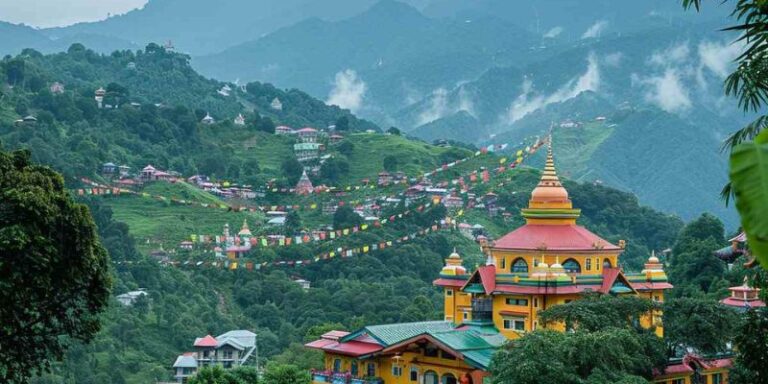A Detailed Guide to Mata Vaishno Devi Trip with Family
Vaishno Devi, nestled in the Trikuta Mountains of Jammu & Kashmir, is one of India’s most revered pilgrimage sites. It draws millions of devotees every year, offering a spiritually fulfilling experience. A family trip to Vaishno Devi can be both a spiritual journey and a bonding experience, with the right planning ensuring a smooth and enjoyable trip.
Here’s a detailed guide to help you plan a comfortable and memorable Vaishno Devi trip with your family:
1. Best Time to Visit
- Peak Season: March to October, especially during festivals like Navratri. The weather is pleasant, but the crowd is larger.
- Off-Season: November to February. Winter months are less crowded, but the weather can be extremely cold with snow in the region.
- Tip: If traveling with elderly family members or children, avoid peak summers and winters. Opt for spring or autumn for moderate weather.
2. How to Reach Vaishno Devi
- By Air: The nearest airport is Jammu Airport (Satwari Airport), about 50 km from Katra, the base camp for Vaishno Devi.
- By Train: Jammu Tawi Railway Station (48 km from Katra) is well connected to major Indian cities. Alternatively, some direct trains go to Katra Railway Station.
- By Road: Katra is well connected by road. You can book a private cab or take state buses from Jammu or nearby cities.
3. Accommodation in Katra
- Budget Options: Several guest houses, dharamshalas, and affordable hotels are available in Katra. The Shri Mata Vaishno Devi Shrine Board also provides budget accommodations like Niharika Bhawan.
- Luxury Options: For more comfort, you can choose hotels like The White Hotels, Country Inn & Suites, or Hotel Bhawani International.
- Tip: Book your stay well in advance, especially during peak seasons. If you prefer Shrine Board accommodations, visit their official website for bookings.
4. Starting the Trek
- Base Camp: The trek to Vaishno Devi starts from Banganga in Katra, about 2 km from the town center. You can walk or take a shared auto to Banganga.
- Trek Distance: The total distance from Banganga to Bhawan (the main temple) is approximately 12-13 km.
- Time: The trek typically takes 4-6 hours, depending on your pace and breaks.
- Trek Timings: The trek is open 24/7. Night treks are common, especially in summer, to avoid the daytime heat.
5. Options for Elderly and Children
- Ponies (Horses): Available for hire from Banganga for those who cannot trek. Pre-booking is not needed, and the rates are regulated by the Shrine Board.
- Palkis: A palanquin service is ideal for elderly family members who require extra assistance.
- Battery Cars: Available from Adhkuwari to Bhawan (6 km stretch). These are especially helpful for seniors and kids.
- Helicopter Service: Operates between Katra and Sanjichhat, which is just 2.5 km from Bhawan. Helicopter rides save time and effort. Tickets can be booked online on the official Shrine Board website.
6. The Trek Route
- Banganga to Charan Paduka (1.5 km): A relatively easy ascent. You’ll find small shops and refreshment stalls along the way.
- Charan Paduka to Adhkuwari (6 km): The path becomes a little steeper. Adhkuwari is a major stop where you can rest and visit the holy cave of the Goddess.
- Adhkuwari to Bhawan (6 km): The final stretch takes you to Bhawan, the sanctum where the deity resides. Facilities on the Trek:
- Resting Points: Covered shelters with benches are available along the way.
- Food & Drinks: Numerous eateries serve vegetarian meals, snacks, and beverages. Shrine Board eateries are clean and affordable.
- Water: Drinking water stations are available frequently along the route.
7. The Vaishno Devi Temple (Bhawan)
- Darshan Procedure: Once you reach Bhawan, you need to obtain a Yatra Slip (if not done already in Katra) for entry. The darshan (viewing the deity) usually happens in an orderly queue. The three Pindis (rocks symbolizing Goddess Durga) are worshipped as Vaishno Devi.
- Facilities at Bhawan:
- Cloakroom: Free cloakrooms are available to store your belongings.
- Blankets: Available for overnight stays at Bhawan’s dormitories or accommodation units.
- Medical Facilities: A dispensary is present in Bhawan in case of emergencies.
8. Other Places to Visit
- Bhairon Temple: After darshan at Vaishno Devi, it is considered auspicious to visit the Bhairon Temple, about 1.5-2 km uphill from Bhawan. A ropeway is available for those who prefer not to walk.
- Adhkuwari Temple: On your way back, don’t miss the Adhkuwari Cave, where it is believed that Mata Vaishno Devi meditated for nine months.
9. Packing Essentials
- Comfortable Footwear: Ensure you have good walking shoes or sandals suitable for trekking.
- Warm Clothing: Even during summer, evenings can be cold at higher altitudes. Bring light woolens. During winter, heavy woolens and gloves are essential.
- Rain Protection: If traveling during the monsoon, carry raincoats or waterproof ponchos.
- First-Aid Kit: Carry basic medicines, especially for altitude sickness, cold, and muscle pain.
- Torch: A small torch is handy, especially if you plan to trek at night.
10. Tips for a Comfortable Family Trip
- Advance Booking: Book your accommodations and helicopter tickets well in advance, especially during peak seasons.
- Stay Hydrated: Drink water frequently during the trek, but avoid overeating heavy foods as it can make the trek difficult.
- Plan for Rest: If traveling with elderly or young children, consider staying overnight at Adhkuwari or Bhawan to break the journey into manageable segments.
- Avoid Overpacking: Keep your luggage light. There are plenty of shops on the way, so you don’t need to carry a lot of snacks or drinks.







